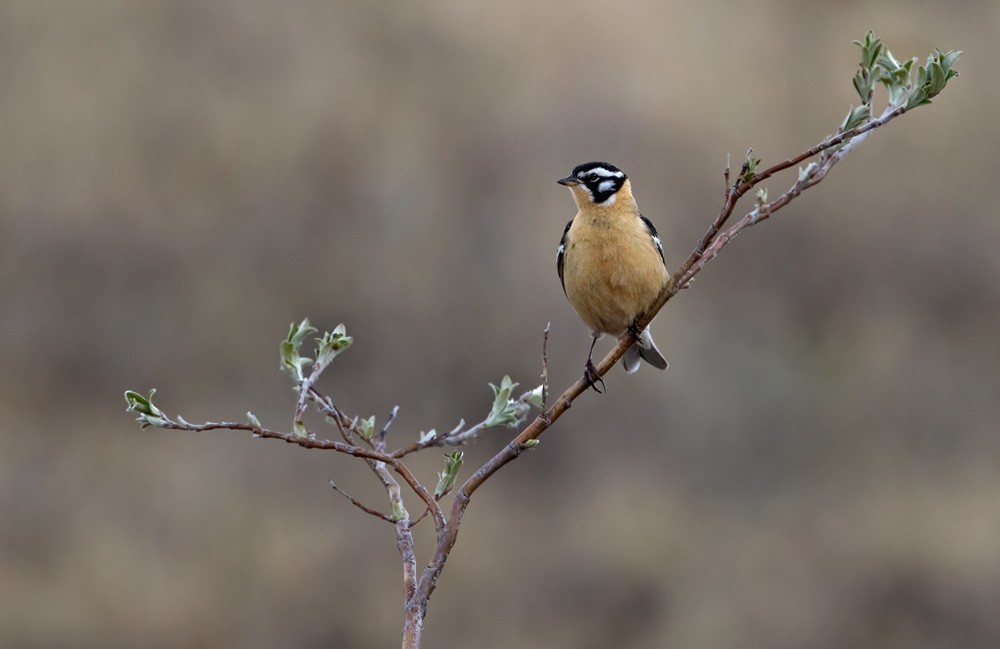Smith's Longspur
A species of Longspurs Scientific name : Calcarius pictus Genus : Longspurs
Smith's Longspur, A species of Longspurs
Botanical name: Calcarius pictus
Genus: Longspurs
Content
Description General Info
 Photo By Lars Petersson
Photo By Lars Petersson Description
These birds have short cone-shaped bills, streaked backs, and dark tails with white outer rectrices. In breeding state plumage (mostly formed by worn basic plumage), the male has a pumpkin-orange throat, nape, and underparts contrasting with an intricate black-and-white face pattern. The white lesser coverts are quite pronounced on a male in spring and early summer. Females and immatures have lightly streaked buffy underparts, dark crowns, brown wings with less obvious white lesser coverts, and a light-colored face. The tail is identical at all ages. Measurements: Length: 5.9-6.7 in (15-17 cm) Weight: 0.7-1.1 oz (20-32 g) Wingspan: 25 cm 
Size
15-17 cm (5.75-6.5 in)
Life Expectancy
4-5 years
Nest Placement
Ground
Clutch Size
1 - 6 eggs
Feeding Habits
Smith's Longspur primarily consume seeds and insects, foraging on the ground without using their feet to uncover food. They de-wing and de-leg insects before eating and husk seeds with their bills. While they sometimes glean insects from foliage or chase them mid-flight, their feeding strategy largely involves flipping through vegetation on the ground. Insects predominate their diet during nesting season, provided to nestlings, and seeds during off-season, including various grasses, forbs, and crops.
Habitat
Smith's Longspur primarily inhabits open grassy areas near the treeline, including arctic lowlands where tundra intersects with boreal forest. This bird favors wet meadows with sedges and rushes, interspersed with dwarf spruce, birch, willow, and tamarack trees, at elevations up to 5600 feet. During breeding, their habitat is patchy, resulting in clustered breeding groups. For migration and wintering, smith's Longspur selects grasslands and fields with key grass species like silver beardgrass and little bluestem, avoiding areas with dense shrubbery or trees.
Nest Behavior
Smith's Longspur females select nesting sites and build nests. Nest construction coincides with the regional tundra season. Egg-laying follows, with specific patterns varying. Both parents partake in nurturing the young, splitting incubation duties and later feeding responsibilities.
Nest Characteristics
Smith's Longspur's nests are found in tundra terrains, typically under shrubs or grass tufts on raised hummocks, slightly sunken into the surroundings. Females construct a grass and sedge stalk cup, lined with hair, wool, lichen, feathers, and caribou hair. They measure 3.8 inches wide, 2.0 inches in diameter, with a 2.2-inch-wide, 1.5-inch-deep inner cup.
Dite type
Insectivorous
General Info
Feeding Habits
Bird food type
Behavior
Smith's Longspur exhibits a complex polygynandrous mating system, where both males and females engage with multiple partners. Unlike typical birds, males do not guard territories through song but use it to attract females and occasionally challenge rivals. Their broad home ranges can overlap extensively, up to 40 acres for males. Instead of defending specific areas, males follow and mate with females, attempting to thwart other males' advances. Conversely, females, with slightly smaller ranges, also actively seek multiple mating opportunities. This behavior culminates in a dynamic social structure where mate selection is primarily driven by female choice.
Distribution Area
This bird breeds in open grassy areas near the tree line in northern Canada and Alaska. In winter, they congregate in open fields, including airports, in the south-central United States. Migration is elliptical, with northbound birds staging in Illinois in the spring and southbound birds flying over the Great Plains in the fall. 
Species Status
Not globally threatened.

 Photo By Lars Petersson
Photo By Lars Petersson Scientific Classification
Phylum
Chordates Class
Birds Order
Perching birds Family
Longspurs and snow buntings Genus
Longspurs Species
Smith's Longspur